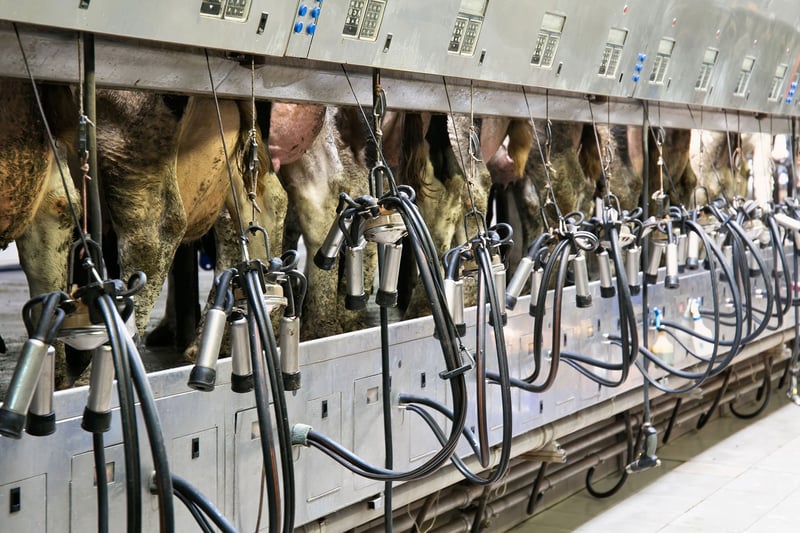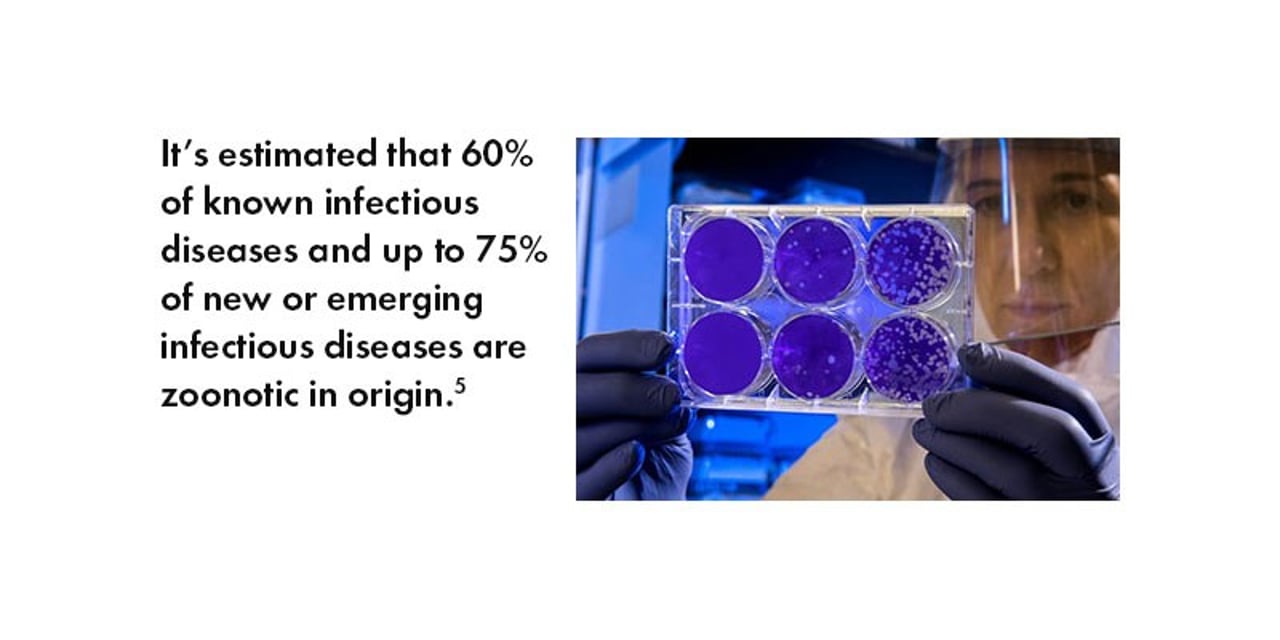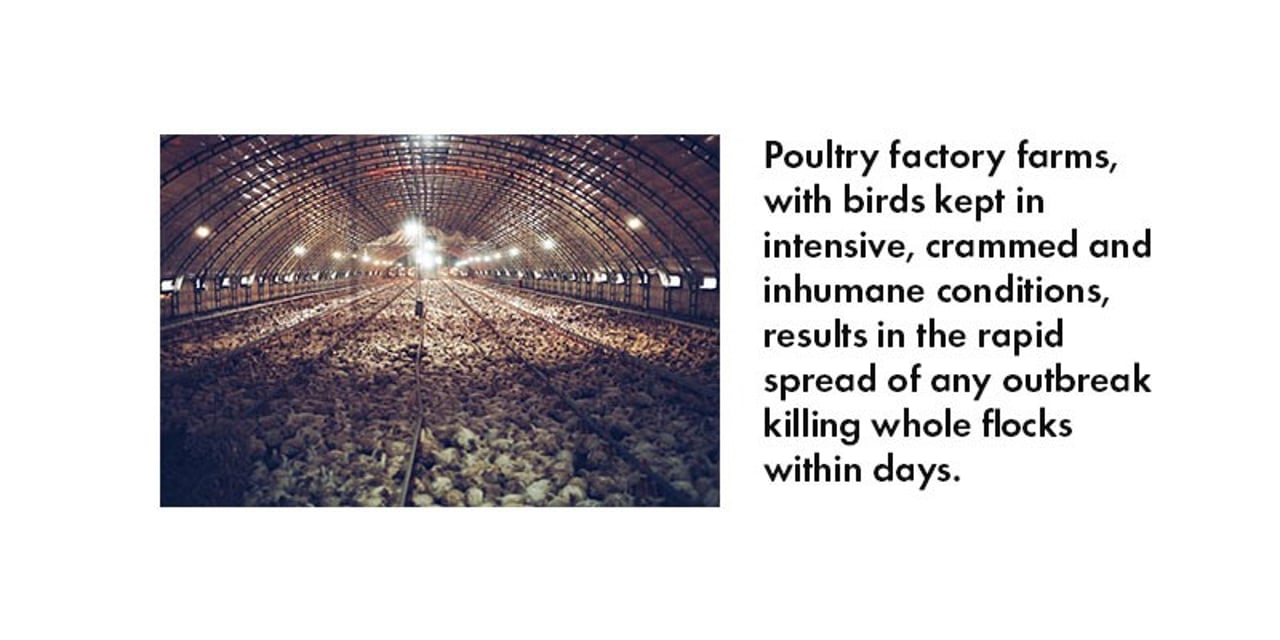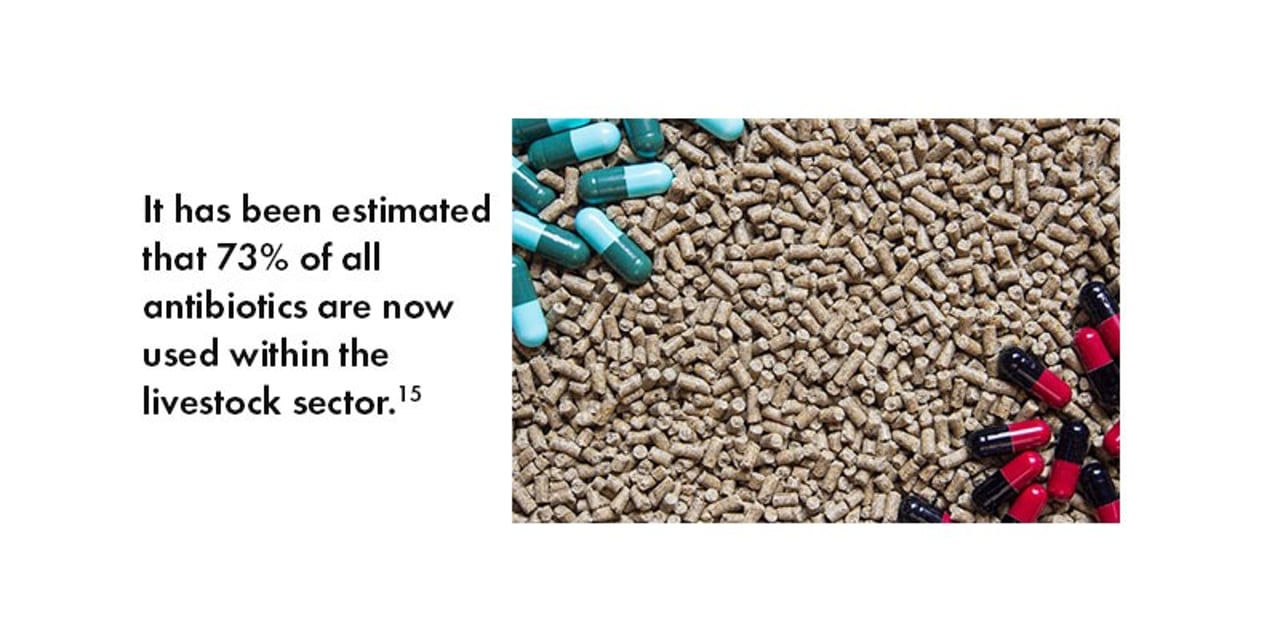
AMR is declared one of the top 10 global public health threats to humanity. With demand for cheaper animal foods, factory farming hides health and financial costs.
In this blog we explore how the world-wide growth of industrial farming practices has negatively impacted human health through an interrelated increase in antimicrobial resistant diseases.
To understand these topics, we need to begin with some definitions:
- Zoonosis is any animal disease communicable to humans.1
- Antimicrobial is something destructive to or inhibiting the growth of microorganisms, including bacteria, viruses, and fungi.1
- Antimicrobial resistance (AMR) – AMR occurs when bacteria, viruses, fungi, and parasites change over time and no longer respond to medicines, making infections harder to treat and increasing the risk of disease spread, severe illness and death.2
- Pathogens are disease-producing agents, especially a virus, bacterium, or other microorganism.1
AMR is a major global health and development threat and declared one of the top 10 global public health threats facing humanity.3
Zoonosis pathogens and AMR are increasing as a direct result of industrial livestock systems growth, and they pose one of the most significant threats to human health across the globe.
Antibiotic overuse, particularly within industrial livestock systems, is a key driver of antimicrobial resistance.4
How are animal diseases transferred to humans?
Zoonotic diseases can be transmitted from farmed or wild animals to humans in several ways.
- Directly transmitted through contact between humans and animals, or through food or insects such as mosquitoes, flies, ticks and fleas.
- Indirectly transmitted through the contamination of the environment: water, surfaces, soils etc.
Image credit: CDC/Unsplash
Many of the most recent pandemics, such as avian flu and swine flu, are associated with intensive poultry and pig production systems with poor animal welfare and animal husbandry standards.6
Factory farming is driven by a global consumer demand for cheaper animal foods which has increased zoonoses risks through:
- high density animal populations
- poor hygiene
- lower animal welfare standards
- genetically similar breeds with less disease resilience
Factory farming of pigs, for example, promoted the transmission of swine flu due to a lack of physical distancing between animals.6
As industrial farming has increased, more natural habitats are converted into farmland for grazing or animal feed production. This process reduces biodiversity and the ability of natural ecosystems to provide crucial functions, such as disease regulation or dilution.7
The human and financial costs of zoonoses
It is estimated that zoonoses are responsible for 2.5 billion cases of human illness and 2.7 million human deaths worldwide each year.8
Zoonotic diseases are prevalent among the poorest and most marginalised populations who live in proximity with their animals or who are dependent on livestock for their livelihoods.
About 70% of the world’s 1.4 billion people living in extreme poverty live close to livestock or fresh markets where diseases spread easily.
The International Monetary Fund (IMF) estimates that the COVID-19 pandemic will cost the global economy USD 9 trillion over the next two years.9
Recent outbreaks of African Swine Fever have had huge a huge economic cost to key emerging markets in Asia. In 2019 half of China’s pig herd (~220 million heads) was lost, while in Vietnam more than 20% of its herd (~6 million) were culled resulting in an estimated economic loss of 0.8% GDP10 and 0.4%-1.5% GDP11 in China and Vietnam respectively.
The environmental impact of zoonoses
The geographic range of some zoonotic diseases is expanding as our planet warms up.12 This is being caused by general climate change and how land use is changing to support industrial farming.
For example, rising temperatures with changes in rainfall patterns in Eastern Africa, have resulted in increasing populations of Aedes mosquitoes and associated outbreaks of Rift Valley fever.13
The African continent has been identified as a likely hotspot for new zoonotic disease emergence.14 It has the world’s fastest-growing human population, expanding settlements and accelerated levels of deforestation increasing the number of encounters between people, livestock, and wildlife.
The devastating impacts of avian influenza in Asia
Avian influenza is the most common form of influenza. It coexists with its’ host species - wild birds.
Image credit: iStock/DuxX
The first avian influenza H5N1 outbreak in humans was recorded in Hong Kong in 1997, and since then the disease has spread throughout Asia with several new variants emerging.
The primary risk factor for humans is exposure to infected live or dead poultry, contaminated environments such as live-bird markets, and intermediate hosts such as domesticated pigs.
Early in 2021, India begun culling tens of thousands of poultry birds after avian influenza was detected in ducks, crows, and wild geese in at least a dozen locations across the country.
In June 2021 China recorded its first human case of infection with a rare strain of bird flu known as H10N3. With a fatality rate for humans up to 60%, avian influenzas continue to be of significant concern for health agencies around the world.
How does factory farming increase antimicrobial resistance?
The resistance of diseases to medical drugs occurs when the bacteria, viruses, fungi, and parasites which cause them to change over time. Their ongoing exposure to antimicrobial treatments stimulates survival adaptations in these pathogens.
Over time, their adaptations mean that they no longer respond to medicines, making the infections caused by them harder to treat and increasing the risk of disease spread, severe illness and death.
Image credit: KOOKLE/Shutterstock
In 2010, the five countries with the largest shares of global antimicrobial consumption in food animal production were all countries associated with the greatest concentrations of factory farms. These countries were: China (23%), the USA (13%), Brazil (9%), India (3%), and Germany (3%).
A positive association between a large farm size and antibiotic use has also been reported from other regions around the world, including Thailand, Nigeria, and the Netherlands.16
As low to middle income countries are expected to shift to more industrial livestock systems, total antibiotics use in animal agriculture is set to increase by 11.5% from 2017 to 2030, from over 93,000 tonnes to over 104,000 tonnes.17
The effects of excess antibiotics on the environment
The antibiotics used in farming are excreted from the treated livestock and fisheries. This waste contaminates soils, water courses and seas, and contributes to the range of resistant strains of bacteria infecting humans.
An investigation by World Animal Protection (WAP) across four countries, Thailand, USA, Canada, and Spain, found that pig factory farms are discharging significant quantities of pig waste (manure and urine). This waste released antibiotic resistance genes and superbugs, into public waterways and the wider environment in all four countries sampled.18
In another USA study, looked at contamination of water courses downstream of pig factory farms in North Carolina. WAP found at least one antibiotic resistance gene in 100% of all water samples tested and three resistant genes in 92% of samples tested.19
How antimicrobial resistance impacts health care providers
Antibiotics are widely used in modern medicine to decrease the risk of infection.
Any procedures where antibiotics are essential to decrease infection risk, such as surgery, cannot be successfully carried out due to the prevalence of AMR.20
In the future, AMR may make performing organ transplants, chemotherapy, and other procedures too risky as they expose patients to different infections, against which, antibiotics may no longer be effective.21
The National Health Service (NHS) in the UK advise that antibiotics are no longer routinely used to treat infections because:
- many infections are caused by viruses, so antibiotics are not effective
- antibiotics are often unlikely to speed up the healing process and can cause side effects
- the more antibiotics are used to treat trivial conditions, the more likely they are to become ineffective for treating more serious conditions
Summary
It is estimated that by 2050 antimicrobial resistant infections will be the leading cause of death globally with a total economic cost of USD 100 trillion. Their overwhelming burden placed on low and middle-income countries.22
To help address this issue, we need to end the growth of factory farming and support a transition to sustainable healthy foods that are good for people, animals and the planet. You can support this process by saying yes to less factory farming.
Say Yes To Less Factory Farming
Read Our Full Hidden Health Risks Report
Make a difference. Join our community.
We campaign to improve animals' lives in the UK and around the world. Why not join us today?
Image credits: Blog post: iStock.com/Sergio Hanquet; Blog listing page: World Animal Protection
References
2. The hidden health impacts of industrial livestock systems report
3. https://www.who.int/news-room/fact-sheets/detail/antimicrobial-resistan… (accessed 24th September 2021).
4. WHO. 2020. Antimicrobial Resistance Factsheet. https://www.who.int/news-room/fact-sheets/detail/antimicrobial-resistan… (accessed 4th October 2021)
5. Salyer, S. J., Silver, R., Simone, K., & Barton Behravesh, C. 2017. Prioritizing Zoonoses for Global Health Capacity Building-Themes from One Health Zoonotic Disease Workshops in 7 Countries, 2014-2016. Emerging infectious diseases, 23(13), S55–S64. https://doi.org/10.3201/eid2313.170418 (accessed 24th September 2021)
6. UN Nutrition. 2021. Livestock-derived foods and sustainable healthy diets. https://www.unnutrition.org/wp-content/uploads/UN-Nutrition-paper-Lives… (accessed 24th September 2021)
7. Schmidt, C.W. 2009. Swine CAFOs & novel H1N1 flu: Separating facts from fears. Environmental Health Perspectives, News, 1 September 2009. https://doi.org/10.1289/ehp.117-a394 (accessed 24th September 2021)
8. Keesing, F., Belden, L.K., Daszak, P., Dobson, A., Harvell, C.D., Holt, R.D. et al. 2010. Impacts of biodiversity on the emergence and transmission of infectious diseases. Nature, 468(7324): 647–652. https://www.nature.com/articles/ (accessed 24th September 2021)
9. Gebreyes WA, Dupouy-Camet J, Newport MJ, Oliveira CJ, Schlesinger LS, Saif YM, et al.2014.The global One Health paradigm: challenges and opportunities for tackling infectious diseases at the human, animal, and environment interface in low-resource settings. PLoS Negl Trop Dis.8:e3257.10.1371/journal.pntd.0003257 (accessed 4th October 2021)
10. ILRI. 2021. Preventing and controlling human diseases transmitted by animals saves millions of lives and livelihoods. Livestock pathways to 2030: One Health Brief 2. Nairobi: International Livestock Research Institute https://cgspace.cgiar.org/bitstream/handle/10568/113056/OH2_brief.pdf?s… (accessed 4th October 2021)
11. You, S., Liu, T., Zhang, M. et al.2021. African swine fever outbreaks in China led to gross domestic product and economic losses. Nat Food 2, https://doi.org/10.1038/s43016-021-00362-1 (accessed 16th December 2021)
12. Nguyen-Thi, Thinh et al. 2021. “An Assessment of the Economic Impacts of the 2019 African Swine Fever Outbreaks in Vietnam.” Frontiers in veterinary science vol. 8 686038. https://www.ncbi.nlm.nih.gov/pmc/articles/PMC8573105/ (accessed 16th December 2021)
13. McFarlane, R. A., Sleigh, A. C., & McMichael, A. J. 2013. Land-use change and emerging infectious disease on an island continent. International journal of environmental research and public health, 10(7), 2699–2719. https://doi.org/10.3390/ijerph10072699 (accessed 4th October 2021)
14. S. de La Rocque, J. A. Rioux, J. Slingenbergh. 2008. Climate change: effects on animal disease systems and implications for surveillance and control. In Climate change: the impact on the epidemiology and control of animal diseases (S. de La Rocque, S. Morand & G. Hendrickx, eds). Rev. sci. tech. Off. int. Epiz, 27 (2), 339-354.
15. Boeckel, T.P.V.; Glennon, E.E.; Chen, D.; Gilbert, M.; Robinson, T.P.; Grenfell, B.T.; Levin, S.A.; Bonhoeffer, S.;Laxminarayan, R. 2017. Reducing antimicrobial use in food animals. Science 2017, 357, 1350–1352 https://www.science.org/lookup/doi/10.1126/science.aao1495 (accessed 24th September 2021)
16. Ström G, Halje M, Karlsson D, Jiwakanon J, Pringle M, Fernstrom LL, et al. 2017. Antimicrobial use and antimicrobial susceptibility in Escherichia coli on small-scale and medium-scale pig farms in north-eastern Thailand. Antimicrob Resist Infect Control. https://aricjournal.biomedcentral.com/articles/101186/s13756-017-0233-9 (accessed 22nd October 2021)
17. Tiseo, K., Huber, L., Gilbert, M., Robinson, T. P., & Van Boeckel, T. P. 2020. Global Trends in Antimicrobial Use in Food Animals from 2017 to 2030. Antibiotics (Basel, Switzerland), 9(12), 918. https://doi.org/10.3390/antibiotics9120918 (accessed 24th September 2021)
18. WAP.2021. Deadly superbugs found in waterways next to cruel factory farms https://www.worldanimalprotection.org/press-release/deadly-superbugs-fo… (accessed 26th October 2021)
19. WAP. 2021. Antibiotic Resistance in the Environment: Factory Farming and Superbug Genes in Rural Streams and Soils
20. Naylor NR, Atun R, Zhu N, et al. 1018. Estimating the burden of antimicrobial resistance: a systematic literature review. Antimicrob Resist Infect Control. https://www.ncbi.nlm.nih.gov/pmc/articles/PMC5918775/ (accessed 22nd October 2021)
21. Li B, Webster TJ. 2018. Bacteria antibiotic resistance: new challenges and opportunities for implant-associated orthopaedic infections. https://www.ncbi.nlm.nih.gov/pmc/articles/PMC5775060/ (accessed 22nd October 2021)
22. O’Neill, J. 2016. Tackling Drug-Resistant Infections Globally: Final Report and Recommendations. London, UK: The Review on Antimicrobial Resistance. https://amr-review.org/sites/default/files/160518_Final%20paper_with%20… (accessed 22nd September 2021)


